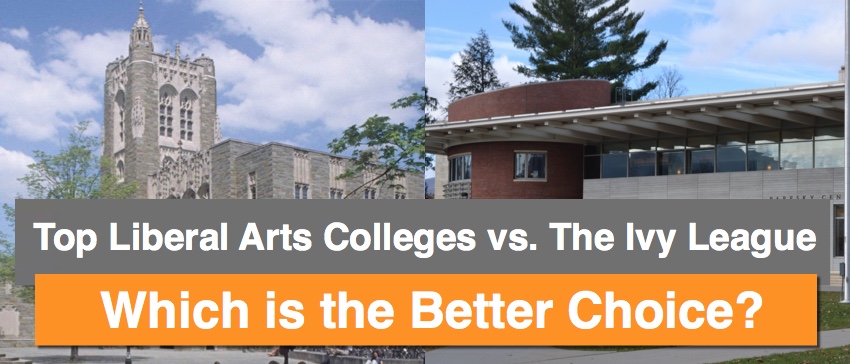 There is a widespread and commonly accepted idea that any high achieving high school senior will find their best educational future at an Ivy League Institution. However, often overlooked are Top Liberal Arts Colleges (some refer to these as the “mini ivys”) that can provide an equal (if not more valuable) education for nearly the same price.
There is a widespread and commonly accepted idea that any high achieving high school senior will find their best educational future at an Ivy League Institution. However, often overlooked are Top Liberal Arts Colleges (some refer to these as the “mini ivys”) that can provide an equal (if not more valuable) education for nearly the same price.
We Surveyed Thousands of Current College Students
We gathered information directly from current students at all eight Ivy League colleges, as well as the nine Top Liberal Arts Colleges (determined by average SAT score of incoming freshmen) to compare the student experience at each kind of college. The list of Top Liberal Arts Colleges includes Amherst, Bowdoin, Carleton, Claremont Mckenna, Harvey Mudd, Haverford, Pomona, Swarthmore, and Williams Colleges.

Princeton University Stanhope Hall
Each of the eight Ivy League colleges are known for their prestige and academic difficulty. For example, four year graduation rate is an excellent indicator of efficiency and effectiveness of any school. Ivy League schools had an impressive average four year graduation rate of 87%. But in fact, the top Liberal Arts colleges’ rates averaged out to 88%.
Here is What We Learned About a Liberal Arts College vs. University
We decided to dig deeper than just the statistics, and find out how the students quantified academic challenges at their schools. Nearly 70% of Liberal Arts Colleges students said that their workload is “difficult” to “very difficult,” whereas only 55% of Ivy students felt the same. Over 90% of Top Liberal Arts College students said they study at least three hours every day, but only three quarters of Ivy students responded in this way. So although the Ivies are known for their difficult academics, students seem to actually have a more challenging academic workload at the top Liberal Arts schools.
Another renowned characteristic of the eight Ivy League schools is an extremely cut throat environment. Every student for his or herself is the attitudinal norm. Our survey results support this idea: 60% of Ivy students said the academic environment at their school was “competitive” to “highly competitive.” On the other hand, 80% of Liberal Arts students said theirs was “collaborative” to “highly collaborative.” A clear line can be drawn here, both kinds of schools will present academic challenges, but a student can find more support from their profs and peers at a Liberal Arts College than an Ivy League school. Given that employers put “ability to work in a team structure” before every other quality when looking to hire candidates, the liberal arts grads clearly have the edge here.

Williams College
College Acceptance Rates at these Little Ivy League Schools
The average SAT score of incoming freshmen at the Ivy League schools is only 40 points higher than that of freshmen entering the top nine Liberal Arts Colleges, yet the average college acceptance rate at one of these Liberal Arts Colleges is nearly twice that of the Ivies. So high-achieving students looking for a rigorous and valuable academic experience have a much higher chance of being able to attend a top Liberal Arts school. For example, even at 12 percent, the Swarthmore College acceptance rate is low but it is still more than twice that of the Harvard College acceptance rate (at less than 6 percent).
Financial Aid
Finances are obviously a huge concern when it comes to choosing the right college, and there is a misconception that the Ivy League schools are much more affordable due to their extensive endowments. It is true that Harvard, Yale, and Princeton have the largest endowments, respectively. However, when this amount is divided by the number of students, the Top Liberal Arts Colleges actually have a higher median endowment per student. This means they have more money to spend initially per student, including grants, which would lower the cost of attendance.

Carleton College Chapel
In addition, the average net price for a family with an annual income of $75,000-$110,000 is about $20,000 for the Ivy League schools, and only $1,700 more for the Liberal Arts Colleges. However, perhaps due to Liberal Arts Colleges schools needing to be more competitive in the market (in order to counter the “Ivy Reputation” factor),average student debt after four years at an Ivy League College is about $23,000, and only $21,000 for the Liberal Arts schools. So, the price difference between these two kinds of schools is actually minimal when debt is taken into account as well.
Professors Focused on Teaching, Not Research
Not only are the top Liberal Arts schools very comparable to the Ivies in both price and quality of education, but they actually come out on top when it comes to relationships with faculty and professors. Over 60% of Liberal Arts students said that their non-teaching staff is “very friendly, helpful, and always accessible.” Only about 40% of Ivy League students said the same.
When it comes to professor relationships, only just over 30% of Ivy students said they talk to their profs outside of class about classroom topics at least once a week, and 30% said they “almost never” have these conversations. Nearly 60% of Liberal Arts students, on the other hand, said they converse with their professors outside of class at least once a week.
These top Liberal Arts schools also had better results when asked how “accessible and approachable” professors and faculty are. 70% of Liberal Arts Colleges students described their faculty as “always helpful and approachable,” whereas only 45% of Ivy students responded in this way.
Social Environment on Campus
Social life is difficult to quantify for an entire group of schools, as it will vary from college to college. However, our results indicated that social life at the Liberal Arts schools was slightly more centered on-campus than at the Ivy League schools. As a result, college-planned activities also seemed to be a little more well-attended at the Liberal Arts Colleges. This could have to do with the somewhat rural location of most of the Liberal Arts Colleges on our list, but like we said, social scene varies at each school.

Columbia University Low Memorial Library
The Bottom Line
When it gets down to the bottom line, about 60% of Ivy League students and 60% of Liberal Arts Colleges students said they were “very satisfied” with their college experience overall. We saw another similar response in that over 70% of students from both types of colleges said they would “definitely recommend” their school to other students.
Clearly an education from any of these 17 schools would highly benefit an ambitious student. What parents and high school students need to understand is that the top Liberal Arts Colleges are very similar to the Ivy League schools, in terms of price and education quality and, in some important categories, the Top Liberal Arts Colleges trump the highly coveted Ivies.
It’s Your Turn. Tell Us What You Think…
So, now that you know what the data says, what do you think? Do agree or disagree with our findings?
Leave a comment below and let us know your thoughts on liberal arts colleges vs. the Ivy League schools.


David says
“High-achieving students looking for a rigorous and valuable academic experience have a much higher chance of being able to attend a top Liberal Arts school.”
If you are interested in learning more about this topic, check out the article on college acceptance rates and their impact on the enrollment process.